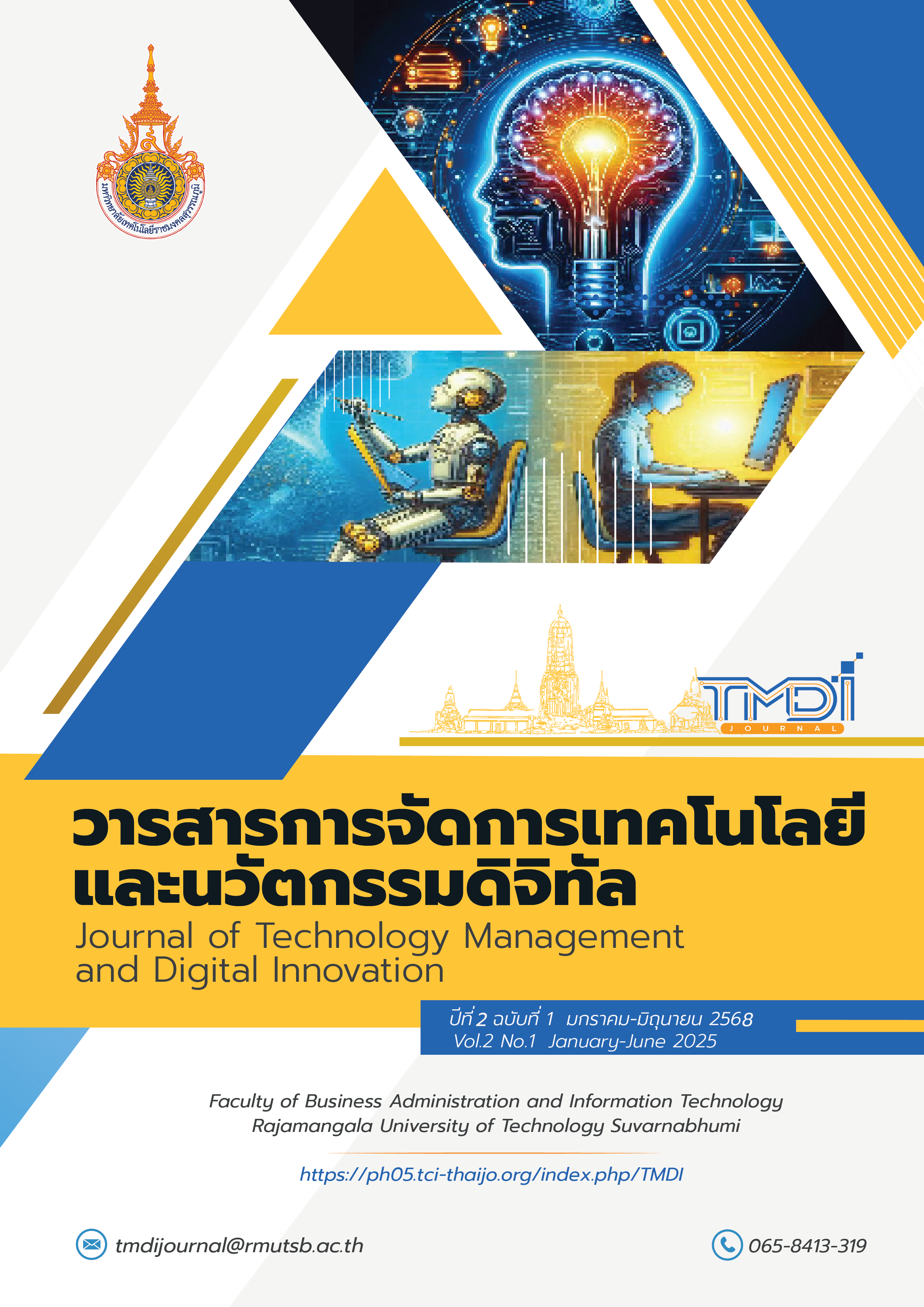การวิเคราะห์เชิงเปรียบเทียบความสัมพันธ์ระหว่างข้อมูล เพื่อคัดเลือกตัวแปรที่มีศักยภาพในการพยากรณ์ด้วยการถดถอยเชิงเส้นอย่างง่าย Comparative Analysis of Data Correlations for Selecting Predictive Variables Using Simple Linear Regression
Main Article Content
บทคัดย่อ
การวิจัยครั้งนี้มีวัตถุประสงค์เพื่อวิเคราะห์ความสัมพันธ์เชิงเส้นระหว่างตัวแปรจากชุดข้อมูลหลากหลาย โดยมุ่งหวังคัดเลือกคู่ตัวแปรที่มีความสัมพันธ์เชิงบวกสูง และมีศักยภาพในการนำไปสร้างแบบจำลองพยากรณ์ด้วยวิธีการถดถอยเชิงเส้นอย่างง่าย (Simple Linear Regression) ผู้วิจัยใช้ข้อมูลทุติยภูมิจากแหล่งเปิดเผยจำนวน 5 ชุด ได้แก่ Heart.csv, StudentMarks.csv, TestEnergyData.csv, Salary_dataset.csv และ Advertising.csv โดยใช้ค่าสัมประสิทธิ์สหสัมพันธ์ของเพียร์สัน (Pearson Correlation Coefficient) และค่าตัวชี้วัดประสิทธิภาพของแบบจำลอง ได้แก่ ค่า R2R^2R2, RMSE และ MAE ในการประเมิน ผลการวิเคราะห์พบว่า ชุดข้อมูล Salary_dataset.csv แสดงค่าความสัมพันธ์สูงที่สุด ( R2=0.9570R^2 = 0.9570R2=0.9570 ) ซึ่งชี้ให้เห็นว่าตัวแปร “ประสบการณ์ทำงาน” มีศักยภาพสูงในการทำนาย “เงินเดือน” ขณะที่ชุดข้อมูล StudentMarks.csv และ Advertising.csv ก็มีค่าความสัมพันธ์ในระดับสูงเช่นกัน ( R2>0.80R^2 > 0.80R2>0.80 ) ส่วนชุดข้อมูล Heart.csv และ TestEnergyData.csv แสดงความสัมพันธ์ในระดับต่ำและปานกลางตามลำดับ การศึกษาครั้งนี้แสดงให้เห็นถึงความสำคัญของการวิเคราะห์สหสัมพันธ์เชิงเปรียบเทียบในการคัดเลือกตัวแปรเชิงปริมาณที่เหมาะสมก่อนการสร้างแบบจำลองทางสถิติ ซึ่งสามารถนำไปประยุกต์ใช้ในงานวิเคราะห์ข้อมูลเชิงพยากรณ์ในหลายบริบท เช่น เศรษฐกิจ การศึกษา และพฤติกรรมผู้บริโภค
Article Details

อนุญาตภายใต้เงื่อนไข Creative Commons Attribution-NonCommercial-NoDerivatives 4.0 International License.
เอกสารอ้างอิง
เจษฎา ขจรฤทธิ์, ปิยนุช ชัยพรแก้ว, และหนึ่งฤทัย เอ้งฉ้วน. (2560). การประยุกต์ใช้เทคโนโลยี Internet of Things ใน
การควบคุมระบบส่องสว่างสำหรับบ้านอัจฉริยะ. วารสารเทคโนโลยีสารสนเทศ, 7(1), 1-11.
นันทิยา ตันติดลธเนศ และแสงทอง บุญยิ่ง. (2563). ต้นแบบการตรวจสอบย้อนกลับการปลูกพืชอาหารปลอดภัยในชุมชน
ด้วยเทคโนโลยีอาร์เอฟไอดี. วารสารวิชาการการประยุกต์ใช้เทคโนโลยีสารสนเทศ, 1(1), 83-98.
Alaba, F. A., Othman, M., Hashem, I. A. T., & Alotaibi, F. (2017). Internet of Things security: A survey.
Journal of Network and Computer Applications, 88, 10-28. https://doi.org/10.1016/j.jnca.2017.04.002
Ashton, K. (2009). That 'internet of things' thing. RFID Journal, 22(7), 97-114.
Date, C. J. (2019). An introduction to database systems (8th ed.). Addison-Wesley Professional.
Duckett, J. (2014). HTML and CSS: Design and build websites. John Wiley & Sons.
Evans, D. (2011). The internet of things: How the next evolution of the internet is changing everything.
Cisco Internet Business Solutions Group.
Flanagan, D. (2020). JavaScript: The definitive guide (7th ed.). O'Reilly Media.
Fraden, J. (2016). Handbook of modern sensors: Physics, designs, and applications (5th ed.). Springer.
Gubbi, J., Buyya, R., Marusic, S., & Palaniswami, M. (2013). Internet of things (IoT): A vision, architectural
elements, and future directions. Future Generation Computer Systems, 29(7), 1645-1660.
https://doi.org/10.1016/j.future.2013.01.010
Kolban, N. (2016). Kolban's book on ESP32. Leanpub.
Moroney, L. (2017). Firebase: The definitive guide. O'Reilly Media.
Myers, G. J., Sandler, C., & Badgett, T. (2011). The art of software testing (3rd ed.). John Wiley & Sons.
Nielsen, J. (2012). Usability engineering. Morgan Kaufmann.
Patel, K. K., Patel, S. M., Scholar, P. G., & Salazar, C. (2020). An efficient key management technique for
the Internet of Things. Sensors, 20(8), 2450. https://doi.org/10.3390/s20082450
Sandhu, R. S., Coyne, E. J., Feinstein, H. L., & Youman, C. E. (1996). Role-based access control models.
Computer, 29(2), 38-47. https://doi.org/10.1109/2.485845
Whitmore, A., Agarwal, A., & Da Xu, L. (2015). The internet of things—A survey of topics and trends.
Information Systems Frontiers, 17(2), 261-274. https://doi.org/10.1007/s10796-014-9489-2

